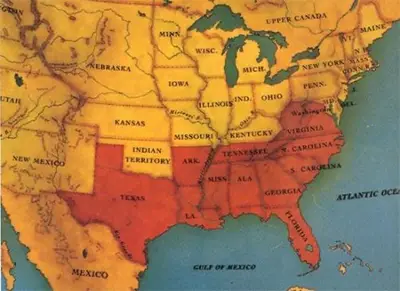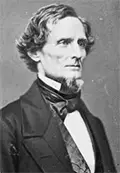The Confederate States of America
Those seven states formed the Confederate States of America on Feb. 8, 1861. The Confederacy, as it came to be known, had its capital at Montgomery, Ala. Named as President of the Confederacy was Mexican War hero and onetime U.S. Secretary of War Jefferson Davis (right, top), of Mississippi. Georgia's Alexander Stephens (right, bottom), a former governor and veteran of the U.S. House of Representatives, was elected Confederate Vice-president. 
Last to join were Virginia (April 17), Arkansas (May 6), North Carolina (May 20), and Tennessee (June 8). Confederate officials then moved the central government to Richmond, Va., (in a vote by the confederate congress that succeeded over President Davis's veto.) The trigger for those four states to join was not only the attack on Fort Sumter, which came on April 12, but also the call by U.S. Abraham Lincoln for a large expansion in the number of troops in the U.S. Army. Also fighting on the side of the states that seceded were two of the famous Five Civilized Tribes. Members of the Choctaw and the Chickasaw tribes entered the fray in Indian Territory (what is now Oklahoma) and in the Confederate Territory of Arizona. On the other side of that transaction were the people living in western Virginia who rejected their state's secession and voted to secede themselves from the Confederate State of Virginia in 1862, forming the new state of West Virginia. The original members of the Confederacy produced a constitution, which they adopted on March 11, 1861. Employing largely the same language as the U.S. Constitution, including that of the Bill of Rights and an almost identical preamble ("We, the people of the Confederate States, each State acting in its sovereign and independent character, in order to form a permanent federal government, establish justice, insure domestic tranquillity, and secure the blessings of liberty to ourselves and our posterity invoking the favor and guidance of Almighty God do ordain and establish this Constitution for the Confederate States of America."), this document specified some details that were specific to the Southern states' interests, in particular restricting the central government in a way that the U.S. Government was not so hindered. In particular:
In the same vein, the constitution provided for apportionment of the two houses of Congress based on population, which included slaves being counted as three-fifths, echoing the "Three-Fifths Compromise" employed in the U.S. Constitution. The constitution went to the Confederate states for ratification and went into effect on Feb. 22, 1862. In the meantime, the provisional government ran the war effort. In its first year, the Confederacy had a unicameral legislature; a house and senate, over which Stephens presided, came along in February 1862. Among the powers granted to Davis at that time, with the war on, was the power to suspend habeas corpus (something that Lincoln had done as well) and to declare martial war. Davis did both, in the case of the latter multiple times. The first flag of the Confederate States of America featured a circle containing 13 white stars, one for each of the 11 states in the Confederacy and one each for Kentucky and Missouri, both of which The 13-star version was the final iteration of the first flag, adopted in December 10, 1861. Previous versions had contained the same number of stripes but, in succession, seven (March 1861), then nine (May 1861), then 11 stars (July 1861). This first flag was called the "Stars and Bars." It was very similar to the U.S. flag, so much so that soldiers reported that it caused confusion on the battlefield. 
A new flag was adopted in 1863. Based on the battle flag, it had a large background, in the upper left corner of which was the familiar meeting of stars, stripes, and triangles. This second Confederate flag was known as the Stainless Banner. 
The third and last flag of the Confederacy began to be used in March 1865. This flag maintained the design of the second flag but added a single vertical wide red stripe at the right of the flag. Every state of the Confederacy but Arkansas (which didn't have a state flag until 1913) had its own new flag as well:
Next page > The Confederacy and the War > Page 1, 2, 3, 4, 5 |
|
Social Studies for Kids
copyright 2002–2025
David White





 the confederate government recognized but neither of which ever joined the Confederacy. The stars were on a blue background. The flag had three horizontal stripes, two red and one white. The stripers were wider than those on the U.S. flag.
the confederate government recognized but neither of which ever joined the Confederacy. The stars were on a blue background. The flag had three horizontal stripes, two red and one white. The stripers were wider than those on the U.S. flag.










